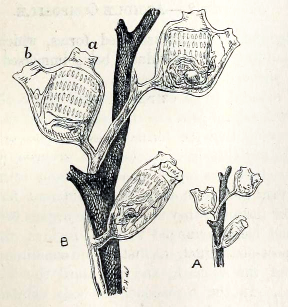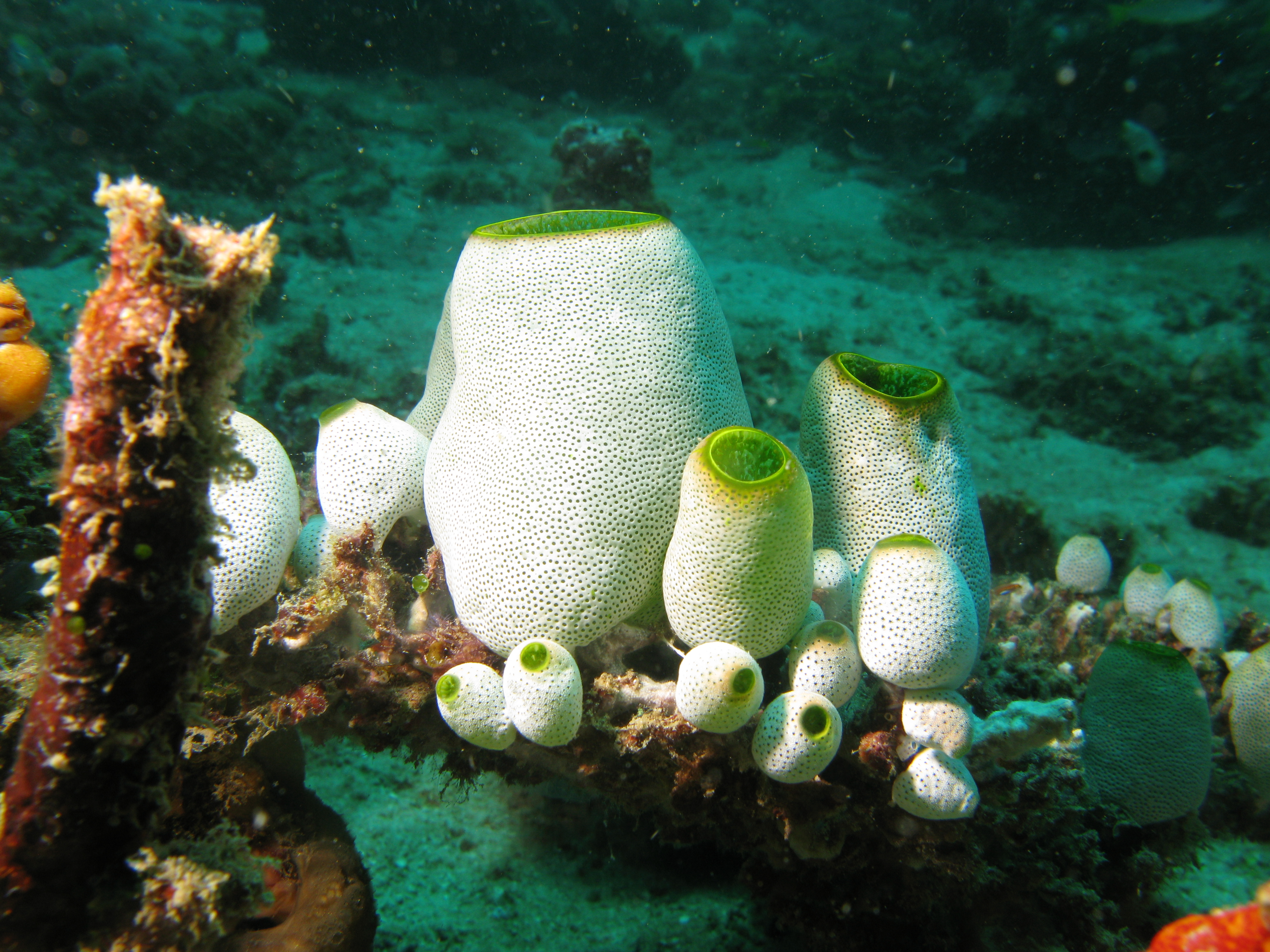|
Perophora Multiclathrata
''Perophora multiclathrata'' is a species of colonial sea squirt in the genus ''Perophora''. It is native to the tropical Indo-Pacific and the western Atlantic Ocean. Description A colony of ''Perophora multiclathrata'' consists of slender, branching stolons, with unstalked zooid A zooid or zoöid is a single animal that is part of a colonial animal. This lifestyle has been adopted by animals from separate unrelated taxa. Zooids are multicellular; their structure is similar to that of other solitary animals. The zooi ...s growing at intervals. Each zooid is long and has about twenty tentacles surrounding the buccal siphon, alternately long and short. The pharynx has five rows of stigmata, some of which extend from the first row into the second. The musculature in the atrial wall is distinctive with horizontal and radial elements and a circular muscle fibre surrounding the base of the atrial siphon allowing the atrium to become pouched and the atrial siphon to be pulled ... [...More Info...] [...Related Items...] OR: [Wikipedia] [Google] [Baidu] |
Animal
Animals are multicellular, eukaryotic organisms in the Kingdom (biology), biological kingdom Animalia. With few exceptions, animals Heterotroph, consume organic material, Cellular respiration#Aerobic respiration, breathe oxygen, are Motility, able to move, can Sexual reproduction, reproduce sexually, and go through an ontogenetic stage in which their body consists of a hollow sphere of Cell (biology), cells, the blastula, during Embryogenesis, embryonic development. Over 1.5 million Extant taxon, living animal species have been Species description, described—of which around 1 million are Insecta, insects—but it has been estimated there are over 7 million animal species in total. Animals range in length from to . They have Ecology, complex interactions with each other and their environments, forming intricate food webs. The scientific study of animals is known as zoology. Most living animal species are in Bilateria, a clade whose members have a Symmetry in biology#Bilate ... [...More Info...] [...Related Items...] OR: [Wikipedia] [Google] [Baidu] |
Chordate
A chordate () is an animal of the phylum Chordata (). All chordates possess, at some point during their larval or adult stages, five synapomorphies, or primary physical characteristics, that distinguish them from all the other taxa. These five synapomorphies include a notochord, dorsal hollow nerve cord, endostyle or thyroid, pharyngeal slits, and a post-anal tail. The name “chordate” comes from the first of these synapomorphies, the notochord, which plays a significant role in chordate structure and movement. Chordates are also Bilateral symmetry, bilaterally symmetric, have a coelom, possess a circulatory system, and exhibit Metameric, metameric segmentation. In addition to the morphological characteristics used to define chordates, analysis of genome sequences has identified two conserved signature indels (CSIs) in their proteins: cyclophilin-like protein and mitochondrial inner membrane protease ATP23, which are exclusively shared by all vertebrates, tunicates and cep ... [...More Info...] [...Related Items...] OR: [Wikipedia] [Google] [Baidu] |
Ascidiacea
Ascidiacea, commonly known as the ascidians, tunicates (in part), and sea squirts (in part), is a polyphyletic class in the subphylum Tunicata of sac-like marine invertebrate filter feeders. Ascidians are characterized by a tough outer "tunic" made of a polysaccharide. Ascidians are found all over the world, usually in shallow water with salinities over 2.5%. While members of the Thaliacea and Larvacea (Appendicularia) swim freely like plankton, sea squirts are sessile animals after their larval phase: they then remain firmly attached to their substratum, such as rocks and shells. There are 2,300 species of ascidians and three main types: solitary ascidians, social ascidians that form clumped communities by attaching at their bases, and compound ascidians that consist of many small individuals (each individual is called a zooid) forming colonies up to several meters in diameter. Sea squirts feed by taking in water through a tube, the oral siphon. The water enters the mouth ... [...More Info...] [...Related Items...] OR: [Wikipedia] [Google] [Baidu] |
Phlebobranchia
Phlebobranchia is a suborder of sea squirts in the class Ascidiacea. Characteristics The group includes both colonial and solitary animals. They are distinguished from other sea squirts by the presence of longitudinal vessels in the pharyngeal basket. This provides the etymology of their name: in ancient greek, means "blood vessel". Another characteristic of phlebobranchians is the gonads being surrounded by a loop of gut. The posterior part of the abdomen is absent, and many species also lack the epicardial cavity that surrounds the heart and other internal organs in many other sea squirts. Taxonomy * ?† Permosomidae ** ?†'' Permosoma tunicatum'' Jaekel 1915 'Sphaerospongia permotessellata'' Parona 1933* Agneziidae Monniot & Monniot 1991 gnesiidae Michaelsen 1898**'' Adagnesia'' Kott 1963 **'' Agnezia'' Monniot & Monniot 1991 'Agnesia'' Michaelsen 1898 non Koninck 1883**'' Caenagnesia'' Ärnbäck-Christie-Linde 1938 **'' Proagnesia depressa'' (Millar 1955) **'' Pter ... [...More Info...] [...Related Items...] OR: [Wikipedia] [Google] [Baidu] |
Perophoridae
Perophoridae is a sea squirts family in the suborder Phlebobranchia Phlebobranchia is a suborder of sea squirts in the class Ascidiacea. Characteristics The group includes both colonial and solitary animals. They are distinguished from other sea squirts by the presence of longitudinal vessels in the pharynge .... References External links Enterogona Tunicate families {{tunicata-stub ... [...More Info...] [...Related Items...] OR: [Wikipedia] [Google] [Baidu] |
Perophora
''Perophora'' is a sea squirt genus in the family Perophoridae. Most species are found in shallow warm water but a few are found in higher latitudes. A colony consists of a number of zooids which bud off from a long slender stolon. Characteristics A ''Perophora'' colony consists of a system of stolons from which individual zooids arise at intervals. Each zooid has four or five rows of stigmata in the wall of the atrium, the one exception being '' Perophora multistigmata'' which has eight rows. In some cases, the five-rowed species have some stigmata extending over the first and second rows indicating that the primary number of rows is four. In '' Ecteinascidia'', the only other genus in the family, there are always eight or more rows of stigmata, usually twelve to twenty rows. Other distinguishing characteristics are that ''Perophora'' has a horizontal gut loop with a short rectum The rectum is the final straight portion of the large intestine in humans and some other ma ... [...More Info...] [...Related Items...] OR: [Wikipedia] [Google] [Baidu] |
Species
In biology, a species is the basic unit of classification and a taxonomic rank of an organism, as well as a unit of biodiversity. A species is often defined as the largest group of organisms in which any two individuals of the appropriate sexes or mating types can produce fertile offspring, typically by sexual reproduction. Other ways of defining species include their karyotype, DNA sequence, morphology, behaviour or ecological niche. In addition, paleontologists use the concept of the chronospecies since fossil reproduction cannot be examined. The most recent rigorous estimate for the total number of species of eukaryotes is between 8 and 8.7 million. However, only about 14% of these had been described by 2011. All species (except viruses) are given a two-part name, a "binomial". The first part of a binomial is the genus to which the species belongs. The second part is called the specific name or the specific epithet (in botanical nomenclature, also sometimes i ... [...More Info...] [...Related Items...] OR: [Wikipedia] [Google] [Baidu] |
Colony (biology)
In biology, a colony is composed of two or more conspecific individuals living in close association with, or connected to, one another. This association is usually for mutual benefit such as stronger defense or the ability to attack bigger prey. Colonies can form in various shapes and ways depending on the organism involved. For instance, the bacterial colony is a cluster of identical cells (clones). These colonies often form and grow on the surface of (or within) a solid medium, usually derived from a single parent cell. Colonies, in the context of development, may be composed of two or more unitary (or solitary) organisms or be modular organisms. Unitary organisms have determinate development (set life stages) from zygote to adult form and individuals or groups of individuals (colonies) are visually distinct. Modular organisms have indeterminate growth forms (life stages not set) through repeated iteration of genetically identical modules (or individuals), and it can be diffic ... [...More Info...] [...Related Items...] OR: [Wikipedia] [Google] [Baidu] |
Tunicate
A tunicate is a marine invertebrate animal, a member of the subphylum Tunicata (). It is part of the Chordata, a phylum which includes all animals with dorsal nerve cords and notochords (including vertebrates). The subphylum was at one time called Urochordata, and the term urochordates is still sometimes used for these animals. They are the only chordates that have lost their myomeric segmentation, with the possible exception of the 'seriation of the gill slits'. Some tunicates live as solitary individuals, but others replicate by budding and become colonies, each unit being known as a zooid. They are marine filter feeders with a water-filled, sac-like body structure and two tubular openings, known as siphons, through which they draw in and expel water. During their respiration and feeding, they take in water through the incurrent (or inhalant) siphon and expel the filtered water through the excurrent (or exhalant) siphon. Most adult tunicates are sessile, immobile and perman ... [...More Info...] [...Related Items...] OR: [Wikipedia] [Google] [Baidu] |
Zooid
A zooid or zoöid is a single animal that is part of a colonial animal. This lifestyle has been adopted by animals from separate unrelated taxa. Zooids are multicellular; their structure is similar to that of other solitary animals. The zooids can either be directly connected by tissue (e.g. corals, Catenulida, Siphonophorae, Pyrosome or Ectoprocta) or share a common exoskeleton (e.g. Bryozoa or Pterobranchia). The colonial organism as a whole is called a ''zoon'' , plural ''zoa'' (from Ancient Greek meaning animal; plural , ). Zooids can exhibit polymorphism. For instance, extant bryozoans may have zooids adapted for different functions, such as feeding, anchoring the colony to the substratum and for brooding embryos. However, fossil bryozoans are only known by the colony structures that the zooids formed during life. There are correlations between the size of some zooids and temperature. Variations in zooid size within colonies of fossils can be used as an indicator of ... [...More Info...] [...Related Items...] OR: [Wikipedia] [Google] [Baidu] |
Enterogona
Ascidiacea, commonly known as the ascidians, tunicates (in part), and sea squirts (in part), is a polyphyletic class in the subphylum Tunicata of sac-like marine invertebrate filter feeders. Ascidians are characterized by a tough outer "tunic" made of a polysaccharide. Ascidians are found all over the world, usually in shallow water with salinities over 2.5%. While members of the Thaliacea and Larvacea (Appendicularia) swim freely like plankton, sea squirts are sessile animals after their larval phase: they then remain firmly attached to their substratum, such as rocks and shells. There are 2,300 species of ascidians and three main types: solitary ascidians, social ascidians that form clumped communities by attaching at their bases, and compound ascidians that consist of many small individuals (each individual is called a zooid) forming colonies up to several meters in diameter. Sea squirts feed by taking in water through a tube, the oral siphon. The water enters the mout ... [...More Info...] [...Related Items...] OR: [Wikipedia] [Google] [Baidu] |







